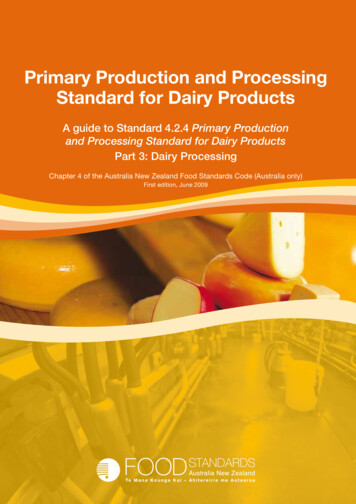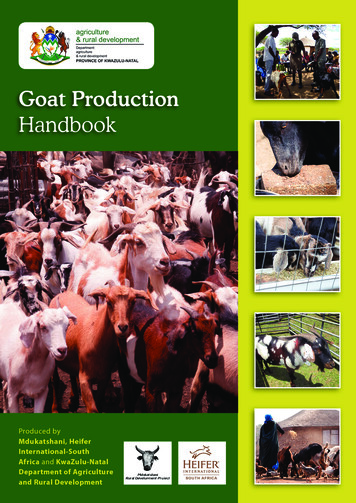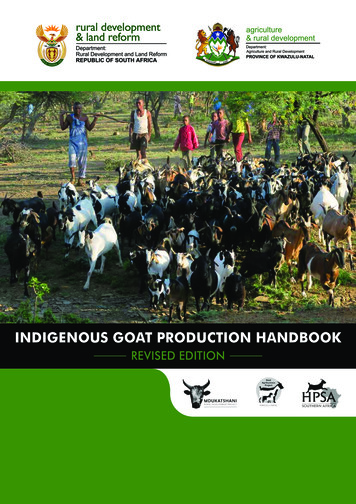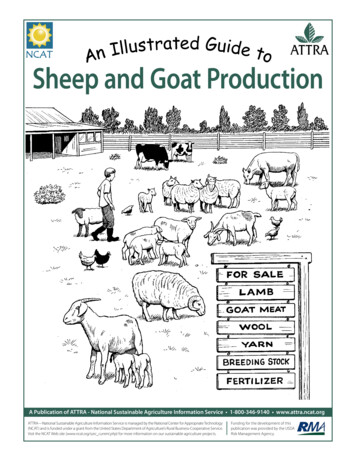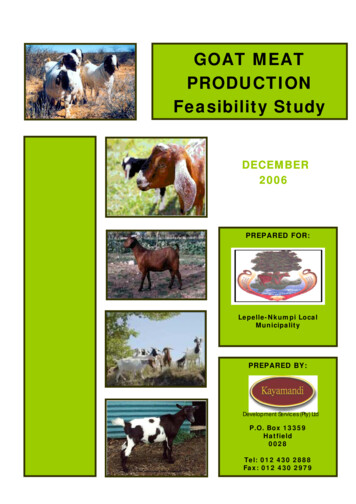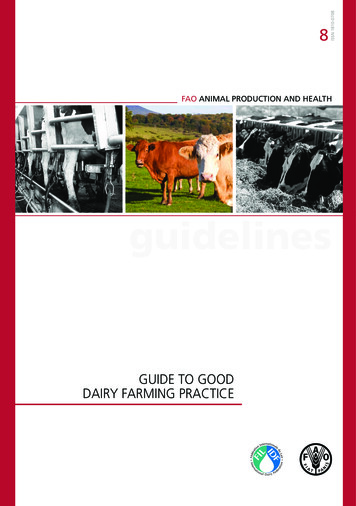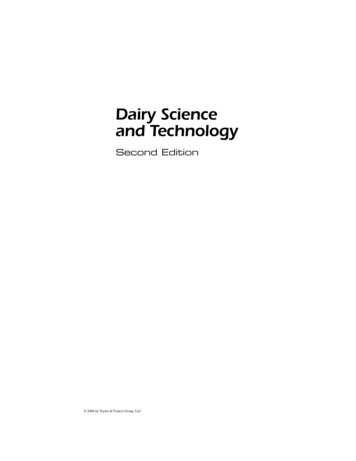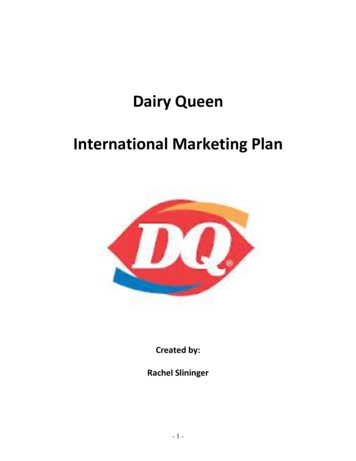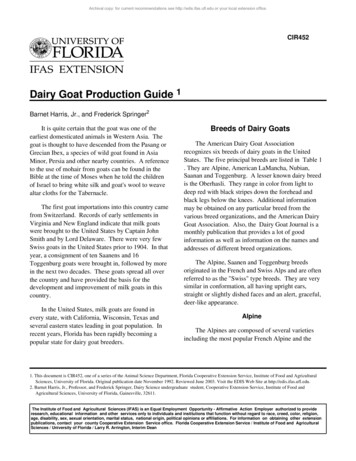
Transcription
Archival copy: for current recommendations see http://edis.ifas.ufl.edu or your local extension office.CIR452Dairy Goat Production Guide 1Barnet Harris, Jr., and Frederick Springer2It is quite certain that the goat was one of theearliest domesticated animals in Western Asia. Thegoat is thought to have descended from the Pasang orGrecian Ibex, a species of wild goat found in AsiaMinor, Persia and other nearby countries. A referenceto the use of mohair from goats can be found in theBible at the time of Moses when he told the childrenof Israel to bring white silk and goat's wool to weavealtar cloths for the Tabernacle.The first goat importations into this country camefrom Switzerland. Records of early settlements inVirginia and New England indicate that milk goatswere brought to the United States by Captain JohnSmith and by Lord Delaware. There were very fewSwiss goats in the United States prior to 1904. In thatyear, a consignment of ten Saanens and 16Toggenburg goats were brought in, followed by morein the next two decades. These goats spread all overthe country and have provided the basis for thedevelopment and improvement of milk goats in thiscountry.In the United States, milk goats are found inevery state, with California, Wisconsin, Texas andseveral eastern states leading in goat population. Inrecent years, Florida has been rapidly becoming apopular state for dairy goat breeders.Breeds of Dairy GoatsThe American Dairy Goat Associationrecognizes six breeds of dairy goats in the UnitedStates. The five principal breeds are listed in Table 1. They are Alpine, American LaMancha, Nubian,Saanan and Toggenburg. A lesser known dairy breedis the Oberhasli. They range in color from light todeep red with black stripes down the forehead andblack legs below the knees. Additional informationmay be obtained on any particular breed from thevarious breed organizations, and the American DairyGoat Association. Also, the Dairy Goat Journal is amonthly publication that provides a lot of goodinformation as well as information on the names andaddresses of different breed organizations.The Alpine, Saanen and Toggenburg breedsoriginated in the French and Swiss Alps and are oftenreferred to as the "Swiss" type breeds. They are verysimilar in conformation, all having upright ears,straight or slightly dished faces and an alert, graceful,deer-like appearance.AlpineThe Alpines are composed of several varietiesincluding the most popular French Alpine and the1. This document is CIR452, one of a series of the Animal Science Department, Florida Cooperative Extension Service, Institute of Food and AgriculturalSciences, University of Florida. Original publication date November 1992. Reviewed June 2003. Visit the EDIS Web Site at http://edis.ifas.ufl.edu.2. Barnet Harris, Jr., Professor, and Frederick Springer, Dairy Science undergraduate student, Cooperative Extension Service, Institute of Food andAgricultural Sciences, University of Florida, Gainesville, 32611.The Institute of Food and Agricultural Sciences (IFAS) is an Equal Employment Opportunity - Affirmative Action Employer authorized to provideresearch, educational information and other services only to individuals and institutions that function without regard to race, creed, color, religion,age, disability, sex, sexual orientation, marital status, national origin, political opinions or affiliations. For information on obtaining other extensionpublications, contact your county Cooperative Extension Service office. Florida Cooperative Extension Service / Institute of Food and AgriculturalSciences / University of Florida / Larry R. Arrington, Interim Dean
Archival copy: for current recommendations see http://edis.ifas.ufl.edu or your local extension office.Dairy Goat Production Guideless numerous British, Rock and Swiss Alpines. Theyare medium to large in size, with color variationsfrom pure white through shades of fawn, gray,brown, black, red buff, and combinations of thesecolors in the same animal. (See Figure 1 .)2NubianThe Nubian is a relatively large, proud, andgraceful dairy goat of Oriental origin, known for highquality, high milk fat percentage. They arecharacterized by long drooping ears, convex nosesand a short, glossy hair coat. Since any color orpattern is allowed, it is the distinctive convex facialprofile between the eyes and the muzzle, and the longbell-shaped ears, that immediately identify the breed.The ears should extend about one-inch beyond themuzzle. They are medium to moderately large in sizewith good stature. (See Figure 3 .)Figure 1.LaManchaThe LaMancha was developed in the U.S. fromcrossing a short-eared goat of Spanish origin withpurebreds of the Swiss breeds. They aredistinguished by very s hort, or the total lack of,external ears. There are two types of La Manchaears: the "gopher" ear and the "elf" ear. Theallowable length of the elf ear is about two inchesand the gopher ear is one inch. There is no preferencefor ear type in does, but bucks must have the"gopher" ear type to be eligible for registration. TheAmerican LaMancha is medium in size with anycolor or combination of colors and a short, glossy haircoat. (See Figure 2 .)Figure 3.SaanenThe Saanens are white or light cream in colorwith white preferred. Spots on the skin are notdiscriminated against. Small spots of color on thehair are allowable, but not desirable. They aremedium to large in size with rugged bone, plenty ofvigor yet feminine throughout. The ears should be ofmedium size and carried erect. A tendency toward aroman nose is discriminated against. (See Figure 4 .)ToggenburgFigure 2.The Toggenburgs are medium in size, sturdy andvigorous. The Toggenburg may be various shades ofbrown with white markings. These white markingsappear as two stripes on the face from eye area tonose, around the outer edge of the ear, from foot toknee, from foot to hock and as a triangular patch oneach side of the tail, covering the pin bone area. Ears
Archival copy: for current recommendations see http://edis.ifas.ufl.edu or your local extension office.Dairy Goat Production Guide3Figure 6.Figure 4.Selecting A Dairy Goat Breedare of medium size and alertly carried. (See Figure 5.)The greatest number of goat owners in thiscountry keep goats for family purposes. In Florida,there are three licensed commercial dairy goatoperations of which two are processing andmarketing Grade A pasteurized goat milk and theother is marketing specialty products such as cheese.Most of the operations in Florida are rather smallwith less than ten milking does. Many of the dairygoats are registered and are exhibited at variousshows throughout the state. The more popular breedsare Nubian, Alpine and LaMancha. The FloridaDairy Goat Association and the annual Florida DairyGoat Production Conference have been helpful inrecent years in providing needed materials andinformation to dairy goat producers.Figure 5.OberhasliThe Oberhasli dairy goat breed is a newer breedto Florida. The dairy goats are of medium size,vigorous and alert in appearance. The color preferredis chamois but does may be black. The chamois colorvaries from a light bay to a deep red bay with thelatter most desirable. Markings include two blackstripes down the face with the forehead nearly allblack, black legs below the knees and hocks, and earsblack inside and bay outside. The face is straight.(See Figure 6 .)The selection of milk goats for commercial dairyherds and breeding herds must be accomplished interms of keeping and maintaining good records, andbecoming familiar with the different strengths thatdairy goats possess. They may or may not beregistered, but must be able to produce milk over along period of time with good care. Good herdsfrequently consist of goats having herd averages of1,500 to 3,000 pounds of milk. The top three dairygoat herds in Florida in 1992 completed DHI 305 daylactation records above 2,100 pounds of milk with thetop herd at 2,934 pounds. For those that are interestedin getting involved in raising or showing dairy goats,start with two kids (three to five weeks old) so theycan get to know you and you can have the enjoymentof watching them grow. It is best that they be of thesame sex, preferably does if you plan to expand. If a
Archival copy: for current recommendations see http://edis.ifas.ufl.edu or your local extension office.Dairy Goat Production Guidebuck is preferred, have the breeder castrate anddehorn the animal prior to taking it home. Also atthis young age, about a quart of milk is needed dailyuntil about 8 weeks of age. At the time of weaning,the doeling should be eating some grain on a dailybasis.The choice of breed is purely a personal one. Werecommend visiting a goat dairy or a dairy goatshows prior to making the final decision on breed.Generally, the breed you start with will end up beingyour preference.Breeding and Artificial InseminationThe normal breeding season for the dairy goat isfrom late August to mid-March. Most of the does arebred in September, October and November andproduce offspring in February, March and April.Because goats are seasonal breeders, the milk supplymay be short for 2-3 months during the late fall andwinter months. Planned matings through good recordkeeping and a sound breeding program will largelyovercome this.Age to Breed DoesDoelings reach puberty by 6 to 8 months of ageand are usually bred at 7 to 10 months of age. At thetime of breeding they should weigh about 80-90pounds (60% of adult weight). If the doelings are notat an optimum weight, breeding should be delayedsince puberty is more dependant on body size thanage. However, delaying breeding much after 10months of age decreases the reproductiveperformance. Growth rates of replacements shouldbe monitored and their nutrition adjusted accordingly.For two to three weeks prior to the breedingseason does and doelings should be gaining weight.This is achieved by increasing the amount of energybeing fed. Does managed in this manner will have anincreased number of ovulations.Signs of EstrusEstrus is the period when the doe will receive thebuck (or the time of Artificial Insemination). Usuallythis period will last from a few hours to 2-3 days andis characterized by frequent and insistent "talking",tail wagging, and pink color as well as swelling in the4external genital region-sometimes with a discharge.A lactating doe will usually drop in her milkproduction. The period between estrus' is from 17-21days. To achieve the highest conception rate , it isbest to breed the doe on day two of her estrus period.During the breeding season bucks have a strongodor and should be kept in separate pens at all times.This will aid you in being able to get the does bredover an extended period of time in order that milkwill be available over a 12-month period and reducethe possibility of off flavors in the milk.Maintain good records and record all heatperiods. Breed to the best buck available if you planto retain the kids. Any notes of her behavior may helpin out-of-season breeding or in detecting estrus earlyin the next heat period.Gestation PeriodThe gestation period is the time from conceptionto kidding. Normally this is a period of 145-155 daysor on the average 5 months. Does producing milk atthe time of breeding will be at their peak production.The doe is usually bred at 45 to 60 days in lactationand will normally be producing milk over a 305 dayperiod. The kidding interval should be about 12months.Artificial InseminationArtificial Insemination (AI) is nothing more thanthe placement of semen in the female reproductivetract by mechanical means rather than by naturalmating. While the term AI does not necessarily implythat the semen used be preserved through priorfreezing, this is the most common situation in dairygoats.The main value of AI lies in its use as a tool forthe improvement of livestock, by extending the use ofbucks that possess desirable characteristics. There isprobably no other sufficient reason (cost, ease,disease control) to consider AI.Raising Dairy Goat KidsKids are born without antibodies circulating intheir blood and rely on antibodies in colostrum, orfirst milk, for protection against disease during the
Archival copy: for current recommendations see http://edis.ifas.ufl.edu or your local extension office.Dairy Goat Production Guidefirst few weeks of life. The antibodies areconcentrated in the doe's udder prior to kidding, aresucked by the kid and then passed through theintestinal wall into the kid's circulation. This transfer,or absorption, is made possible by special cells in theintestinal lining that permit antibodies to pass throughfor the first 18 hours of life. After that time, the cellsare eliminated and no further antibodies can enter theblood stream. It is critical then, that kids suckle soonafter birth, preferably within 2-4 hours. Colostrum isalso high in nutrient value, especially vitamin A,B-vitamins, proteins, and minerals. The proteincontent of colostrum is about 20% as compared to3.5% for normal milk.Overfeeding colostrum or other milk to kids cancause loose bowels and possibly scours. The extracolostrum should be placed in the refrigerator and fedlater at about body temperature. The kid must behandled gently and not forced to drink. After a fewhours, the hungry kid will drink readily. The kid maybe changed to goat's milk, cow's milk, or powderedmilk after about one day on colostrum. Provide about2 to 3 pints of milk each day in 3 to 4 feedings thefirst 2 to 3 days and twice per day thereafter.At birth, the kid weighs approximately 7 to 9pounds, heart girth 14 to 15 inches, and height atwithers 14 to 15 inches. The kid must be treated as asimple stomach animal such as the dog or cat. Thatis, a milk diet is needed for the first few weeks of life.A small amount of grain such as a calf starter or goatchow may be introduced to the kid at 2 to 3 weeks ofage. In general, the grain should contain about 14 to15% crude protein with added minerals and vitamins.As soon as the kid starts eating, the rumen startsdeveloping and eventually the kid will start chewingits cud. This is an indication that all fourcompartments of the stomach (rumen, reticulum,omasum and abomasum) are developing. Animalshaving four-compartment stomachs are referred to asruminants. As the animal grows, the rumen becomesthe largest compartment.Clean, fresh water and salt blocks should beavailable at all times and especially as the kid isweaned from receiving milk at 8 to 12 weeks of age.Start the kids drinking from a bucket as you5discontinue milk feeding. Also, be sure the kid hasstarted eating some grain and hay.All kids should be dehorned at 2 days to 1 weekof age, except those that are naturally hornless.Electric dehorners are frequently used with excellentsuccess. Instructions may be received from yourCounty Extension Agent or a local dairyman. Theprocess appears painful but is rather short and causesno harm. An ointment may be applied to the burnedarea. Dehorning may also be done by a veterinarianunder anesthesia. This allows for a more accurateoperation with no pain to the kid.Dairy Goat Feeding and ManagementProgramsGoats are energetic, inquisitive and versatile intheir feeding habits. An area near the barn thatprovides some browse materials (trees, leaves,bushes, twigs, etc.) appears to be advantageous andenjoyed by dairy goats. The importance of suchmaterials toward the nutritional requirements oflactating dairy goats is probably quite small,especially where a fairly large number of dairy goatsare being maintained.Good quality hay and a balanced grain mixappear to be the best approach in maintaining highlevels of milk production. Fiber in the total ration isneeded to maintain a normal milk-fat test. However,too much poor quality fiber will lead to loweredlevels of milk production. Rations containing somecottonseed hulls or other fibers may be included inthe grain where hay or other roughages are notreadily available.The success of a dairy goat enterprise isdependent on the establishment of a good feeding andmanagement program ( see Circular 761 on Feedingand Management of Dairy Goats for furtherinformation ). Nonlactating dairy goats do well ongood pastures supplemented with minerals.Permanent pastures may consist of several varietiesof grasses including bermuda, bahia and pangolagrassand a number of legumes including clovers andperennial peanuts. Summer annual grasses includeseveral varieties of Pearl millet andsorghum-sudangrass. Both are erect, tall-growing,high-producing annuals. Sorghum-sudangrass is
Archival copy: for current recommendations see http://edis.ifas.ufl.edu or your local extension office.Dairy Goat Production Guideadapted to drier soils than millet. Winter annualgrasses include rye, oats, wheat, barley and ryegrass.Excellent grazing may be obtained from wintergrasses under conditions suitable for growing them.Legumes make excellent hay and are usuallysuperior to most other hay crops because of theirhigher protein content. While alfalfa hay is the bestlegume hay, variations may occur in quality. Goodquality alfalfa hay should have a green color, smallstem, adequate in leaves and 17-20% protein. Otherlegume hays that may be available are alyce cloverand perennial peanut.Grass hay usually varies considerably in quality.Even so, some grass hay may be used in the rationwith success. Grass hay as the only roughage sourcemay limit maximum performance. In addition topasture and/or the forages being fed, the overallration should be balanced with a good grainconcentrate that is fortified with minerals andvitamins. The exact amount needed will vary withpasture and forage quality.Dairy goats are good eaters and can consumefrom 4 to 7% dry matter (DM) per 100 lbs bodyweight as compared to 3-4% DM consumption fordairy cows. This high level of intake allows the dairygoat to have an abundance of nutrients readilyavailable for the synthesis of milk. Overall, theefficiency of milk production by the dairy goat isquite similar to that of the dairy cow.Important factors to consider when selectinggrain rations for dairy goats is quality of forage orroughage being fed as well as the kind of forage.With most grasses and silages in Florida, an 18-20%protein grain mixture is needed to supplement theforage since corn and/or sorghum silage and averagequality grass hays are low in digestible protein. Withgood quality hay (15-20% protein) or the use ofsmall grain pastures such as oat, rye and ryegrass, a14-16% protein grain mix is generally adequate. Therequirements of dairy goats are in Table 2 .Both dairy goats and dairy cows are ruminantanimals and can therefore eat the same kind of ration.Common ingredients used are cracked corn, rolledoats, cane molasses, cottonseed hulls, soybean meal,wheat midds and soybean hulls. Assistance may be6needed in balancing and formulating the overallration to prevent problems associated with poornutrition.Dry PeriodThe doe should be bred to freshen once each yearwith a dry period of about two months. The dryperiod allows the mammary system time to repair andregenerate for the next lactation. The greater herproduction the more likely that her body has beendepleted of the nutrients used in milk secretion andthe longer the dry period required to replenish thelosses and store adequate reserves for the nextlactation. Does which are not given a normal dryperiod usually produce only 65 to 75% as much milkin the subsequent lactation as does given a dry period.Grain consumption should be reduced orremoved near the time that the dairy goat is turneddry. See Circular 761 for additional information onfeeding dairy goats. At the time of drying-off,substitute fair to good quality grass hay for alfalfa orother sources of legume hay. The dairy goat shouldbe down to about three pounds of milk per day orless. Her milk flow will be reduced quicker if youchange her routine at the same time you discontinuemilking. Since mastitis is frequently started duringthe dry period, check her udder for possible problemssuch as mastitis. A certain amount of pressure isneeded in the udder in order to stop milk secretionand flow. If the doe has had mastitis during herlactation, this is the best time to treat it with anappropriate antibiotic for treating dry cows or goats.The dairy goat should be maintained in goodcondition during the dry period so she will freshen ina healthy state and have every opportunity to producemore milk in the next lactation. A good mineralmixture should be available. A purchased mineralmay contain from 12 to 18% calcium, 6 to 8%phosphorus and 25 to 30% salt, with trace mineralsand vitamins. The exact ratio of calcium tophosphorus needed is dependent on forage sourcesince legumes are higher in calcium than grasses.During the last 3 to 4 weeks of gestation,nutrition becomes more important to the doe. Sheshould receive a better quality grass hay and about thesame type of ration she will receive after kidding.
Archival copy: for current recommendations see http://edis.ifas.ufl.edu or your local extension office.Dairy Goat Production Guide7The doe should be managed during the dryperiod so that she is in good condition at the time ofkidding. She should not be allowed to become fat.The key to success is to have the doe kid in a healthycondition and with a fairly good appetite.insecticides are frequently changed and taken off themarket, contact your local County Extension Agentabout current recommendations.HousingA number of common diseases occur frequentlyin dairy animals. Most of these diseases are welldocumented and information is readily available atthe University of Florida. While the followinginformation will be brief, it may help you detectpossible problems and obtain more detailedinformation.A small barn or shed is needed to reduce theexposure of goats to wind, rain and solar radiation.The type of housing needed will vary with thenumber of goats owned and the conveniencepreferred. A stanchion or box stall with built-infeeder may be advantageous for milking.Common Diseases of Dairy GoatsMastitisDoes are usually milked on a stand 12 to 18inches high or higher if preferred. The stand shouldbe long enough for the doe to stand comfortably andabout 18 to 20 inches in width. The stanchion shouldbe placed at the front of the stand in order to fastenthe doe's head. A small runway may be constructedto the stand to reduce possible udder injury. It is bestto construct in an area that can be cleaned easily.ParasitesInternal Parasites - It is important that your dairygoats live in a good and clean environment ( seeCircular 1023 on Common Internal Parasites ofGoats in Florida ). A good parasite control programshould be initiated as soon as you obtain your firstanimal. The reason is because parasites begin togrow in numbers and will build-up on closely eatengrassy areas near the barn. Pastures and lots remaincontaminated for long periods and goats may pick upthe parasites. Inside the animal, they can interferewith nutrients, cause diarrhea, or result in poorperformance of the animal. A good wormingprogram is a necessity for successful dairy goatfarming in Florida.External Parasites - Parasites including lice,ticks, horn flies, house flies, stable flies, horse flies,deer flies and mosquitoes present serious problemsduring the year. These pests are most prevalentduring the spring and summer months. Many are aproblem throughout the entire year in Florida.Lice, both biting and sucking varieties, maypresent a real problem if not controlled. SinceMastitis is simply an inflammation of the udder.It may be rather acute or chronic. Most cases arecaused by streptococcus or staphylococcusorganisms.The udder may appear hot, painful, tense, andhard. A wide spectrum antibiotic may be needed orsimply penicillin may be effective. The disease canbe cured if treated early.Sanitation during milking is important in thecontrol of mastitis and the making of a cleanwholesome dairy product. Many mastitis-causingorganisms are present in the environment and canfind their way into the udder and milk pail if goodsanitation is not maintained. Manure should beremoved from the milking areas as frequently asneeded.If milking machines are used, the teat cupsshould be kept clean and dipped into clean water andthen a sanitizing solution between goats. Teat cupliners should be free of cracks, milkstone, andballooning. Machines should be properly cleaned,sanitized, and stored after each milking. Cleanequipment will reduce chances of mastitis and lowerbacteria counts in milk.Udder EdemaUdder edema and congestion is commonlyobserved in high producing dairy goats during thelate dry period and after parturition. While theproblem cannot be totally controlled, limiting the useof sodium (salt) and potassium (good sources are
Archival copy: for current recommendations see http://edis.ifas.ufl.edu or your local extension office.Dairy Goat Production Guidealfalfa hay and cane molasses) as well as high energyfeedstuffs such as corn meal in the dry period ishelpful. While some corn meal is acceptable, thelevel fed should be limited to about 20% of the ration.The total ration dry matter should contain about 0.2to 0.3% sodium and 0.7% potassium. While a lowerenergy and higher fiber ration is needed for the drydoes, lactating does need higher energy feedstuffs intheir ration with adequate amounts of good qualityforages.Caseous Lymphadenitis (Abscesses)This is a common chronic disease of adult goatswhere abscesses arise from the lymph nodes,particularly about the head, neck and shoulder. Thisdisease may eventually cause emaciation and death ofthe affected animal due to internal abscessesinterfering with vital organs.The abscesses should be lanced after becomingsufficiently organized near the surface of the skin andthe pus carefully collected and disposed of. Fourdaily shots of penicillin and flushing of the woundwith an antiseptic solution until healed should follow.During treatment, the animal should be isolated andthe area around the wound washed and dried beforereturning her to the herd.Eradication of caseous lymphadenitis from aherd can only be done through a planned program ofraising offspring in separate facilities and thendisposing of the infected animals. The use of anautogenous bacterin prepared by a laboratory isthought to be helpful in reducing the incidence ofdisease. No commercial vaccine is presentlyavailable.Contagious Ecthyma (Sore Mouth)Sore mouth is caused by a resistant virus whichproduces scabs about the lips and gums.Transmission is through the virus which is containedin the scabby material, which may remain viable inthe soil for a long period of time. This disease in kidsis more serious as it prevents normal eating due to thesensitive areas and if nursing, the infection mayspread to the teats of the does. Immunity isdeveloped after the initial infection. A vaccinationprogram is valuable in preventing the disease.8Treatment is aimed at preventing a secondarybacterial infection. Gently remove the scabbymaterial with hydrogen peroxide and gauze, thencover the area with zinc oxide or similar ointment.Plastic gloves should be worn as it is transmissible tohumans.Enterotoxemia (Overeating Disease)Enterotoxemia is caused by a sudden change infeed or overeating by very hungry animals, where thecausative bacteria undergoes rapid growth andreleases a toxin in the intestines. Regular feeding andvaccinating with Clostridium perfringens, type C andtype D toxoid will prevent this disease. Adult animalsmay show depression, intoxication and incoordinationwhereas in kids, it often just shows up as suddendeath.Foot RotFoot Rot can best be prevented by housing yourgoats in a relatively dry area. The germ which causesfoot rot thrives in wet muddy areas where air ispoorly circulated.Symptoms include a grayish cheesy dischargeand foul odor with lameness and intense pain. Treatby carefully trimming away the rotten area andtreating the infected area with 10 to 30% coppersulfate, a suitable ointment, or other treatment asprescribed by your veterinarian. Proper trimming ofthe feet will help to reduce infection by the organism.Ring WormSkin infections such as ring worm requiretreatment. Treatment includes using a solution ofglycerine or tincture of iodine. Daily treatment orapplications of a mixture of equal parts tincture ofiodine and glycerin or a 20% solution of sodiumcaprylate to the lesion until it disappears often iseffective. The antifungal activity of thiabendazolemay provide a useful treatment.Composition of Goat's MilkThe composition of goat's milk varies bothwithin and between breeds. Various values have beenreported for each of the nutrients. This hasundoubtedly resulted from analyzing milk from a
Archival copy: for current recommendations see http://edis.ifas.ufl.edu or your local extension office.Dairy Goat Production Guidesingle breed, a single herd, or the analyticaltechniques used. Goat's milk contains more fat andash than cow's milk, but has less lactose ( Table 3 ).Generally, the composition of goat's milk can beexpected to fall within a specified range for each milkcomponent. Fat, the most variable component, willusually fall between 3.0 to 6.0% in herd samples.However, values outside this range are notuncommon for individual samples. The ranges thatcan be expected for total solids, protein, lactose, andash are 12-16, 3-4, 3.8-4.8 and 0.70-0.95respectively.ProteinThe protein in goat's milk can be divided intocasein and whey protein. Casein accounts for about83% of the total protein and is the primary proteinfraction in cheese products. Casein will coagulateunder certain conditions and can be removed fromthe milk. Rennet, acid, and a combination of pepsinand acid will all coagulate casein in milk. Eachmethod closely resembles a natural process of caseincoagulation. Rennet coagulation is the process that isused in cheese making. The addition of acid increasesthe acidity of milk until the casein
at an optimum weight, breeding should be delayed since puberty is more dependant on body size than age. However, delaying breeding much after 10 months of age decreases the reproductive performance. Growth rates of replacements should be monitored and their nutrition adjusted

